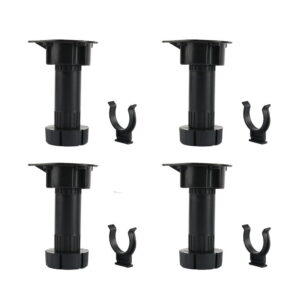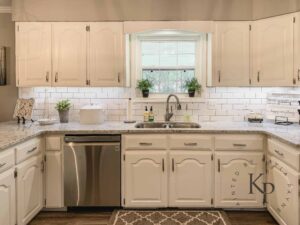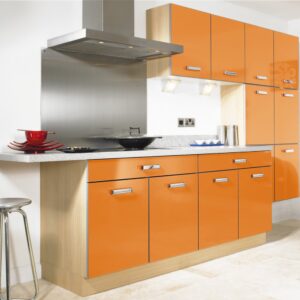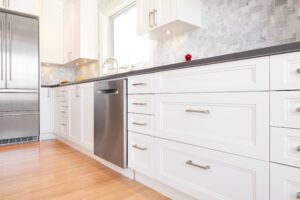When it comes to kitchen renovations, choosing the right cabinets is essential. They not only provide storage but also play a significant role in the overall aesthetic of the space. Acrylic kitchen cabinets have gained popularity in recent years due to their sleek and modern look. However, like any other material, they come with their own set of pros and cons. In this article, we will explore the advantages and disadvantages of acrylic kitchen cabinets, providing valuable insights to help you make an informed decision for your kitchen renovation project.
The Pros of Acrylic Kitchen Cabinets
1. Aesthetic Appeal
Acrylic kitchen cabinets are known for their high-gloss finish, which adds a touch of elegance and sophistication to any kitchen. The smooth and reflective surface of acrylic cabinets can instantly elevate the overall look of the space, making it appear more contemporary and stylish.
2. Durability
One of the biggest advantages of acrylic kitchen cabinets is their durability. The material is resistant to scratches, stains, and impact, making it ideal for high-traffic areas such as the kitchen. Unlike wood cabinets, which may require regular maintenance and refinishing, acrylic cabinets are relatively low-maintenance and can withstand daily wear and tear.
3. Moisture Resistance
Kitchens are prone to moisture, and this can be a challenge for cabinet materials. However, acrylic kitchen cabinets are highly resistant to moisture, making them an excellent choice for humid environments. The non-porous surface of acrylic prevents water damage, warping, and mold growth, ensuring the longevity of your cabinets.
4. Easy to Clean
Keeping your kitchen cabinets clean is essential for maintaining a hygienic and visually appealing space. Acrylic cabinets are easy to clean, requiring only a mild detergent and a soft cloth. The smooth surface of acrylic does not trap dirt or grime, allowing for effortless cleaning and maintenance.
5. Color Options
Acrylic kitchen cabinets offer a wide range of color options to suit various design preferences. Whether you prefer bold and vibrant hues or subtle and neutral tones, there is an acrylic cabinet color that can complement your kitchen style. The availability of different finishes, such as matte or high-gloss, allows for further customization.
6. Reflects Light
If you have a small kitchen or one with limited natural light, acrylic cabinets can help create the illusion of a brighter and more spacious space. The reflective properties of acrylic can bounce light around the room, making it appear larger and more inviting.
The Cons of Acrylic Kitchen Cabinets
1. Cost
One of the main drawbacks of acrylic kitchen cabinets is their cost. Acrylic is generally more expensive than other cabinet materials such as laminate or wood veneer. The high-quality finish and durability of acrylic contribute to its higher price tag. However, it’s important to consider the long-term benefits and value that acrylic cabinets can bring to your kitchen.
2. Susceptible to Scratches
While acrylic cabinets are generally scratch-resistant, they are not entirely immune to scratches. Sharp objects or abrasive materials can leave marks on the surface of acrylic, compromising its aesthetic appeal. It is important to handle and clean acrylic cabinets with care to minimize the risk of scratches.
3. Limited Repair Options
If your acrylic kitchen cabinets get damaged, repairing them can be more challenging compared to other materials. Unlike wood cabinets that can be sanded down and refinished, acrylic cabinets may require professional assistance to fix scratches or chips. It is essential to consider the long-term maintenance and repair costs associated with acrylic cabinets.
4. Fingerprints and Smudges
The high-gloss finish of acrylic cabinets, while visually appealing, can also be prone to fingerprints and smudges. This can be especially noticeable on darker-colored cabinets. Regular cleaning and maintenance are necessary to keep the cabinets looking pristine, which may require more effort compared to other materials.
5. Chemical Sensitivity
Acrylic cabinets can be sensitive to certain chemicals, including harsh cleaning agents. It is important to avoid using abrasive cleaners or solvents that can damage the surface of the cabinets. Always follow the manufacturer’s recommendations for cleaning and maintenance to ensure the longevity of your acrylic cabinets.
Conclusion
Acrylic kitchen cabinets can be a stylish and durable choice for your kitchen renovation project. Their high-gloss finish, durability, moisture resistance, and easy maintenance make them a popular option among homeowners. However, it is important to consider the higher cost, susceptibility to scratches, limited repair options, and the need for regular cleaning to keep them looking their best. By weighing the pros and cons, you can make an informed decision that suits your style, budget, and maintenance preferences.
FAQs About Acrylic Kitchen Cabinets
1. Are acrylic kitchen cabinets more expensive than wood cabinets?
Yes, acrylic kitchen cabinets are generally more expensive than wood cabinets. The high-quality finish and durability of acrylic contribute to its higher price tag.
2. Can I repair scratches on acrylic cabinets myself?
While minor scratches on acrylic cabinets can be buffed out with a mild abrasive, more significant damage may require professional assistance. It is recommended to consult a professional for repairs to ensure the best results.
3. How do I clean and maintain acrylic kitchen cabinets?
To clean acrylic kitchen cabinets, use a mild detergent and a soft cloth. Avoid using abrasive cleaners or solvents that can damage the surface. Regular cleaning and maintenance are necessary to keep the cabinets looking their best.
4. Can I install acrylic cabinets in a high-humidity environment like a coastal area?
Yes, acrylic cabinets are highly resistant to moisture, making them suitable for high-humidity environments like coastal areas. Their non-porous surface prevents water damage, warping, and mold growth.
5. Are there alternatives to acrylic kitchen cabinets?
Yes, there are several alternatives to acrylic kitchen cabinets, including laminate, wood veneer, and thermofoil. Each material has its own pros and cons, so it’s important to consider your specific needs and preferences when choosing cabinets for your kitchen.
Summary
Acrylic kitchen cabinets offer a sleek and modern look to any kitchen, with their high-gloss finish and wide range of color options. They are durable, moisture-resistant, and easy to clean, making them a popular choice among homeowners. However, acrylic cabinets can be more expensive than other materials, susceptible to scratches, and may require professional repairs. Regular cleaning and maintenance are necessary to keep them looking their best. By considering the pros and cons, you can decide if acrylic kitchen cabinets are the right choice for your kitchen renovation project.





